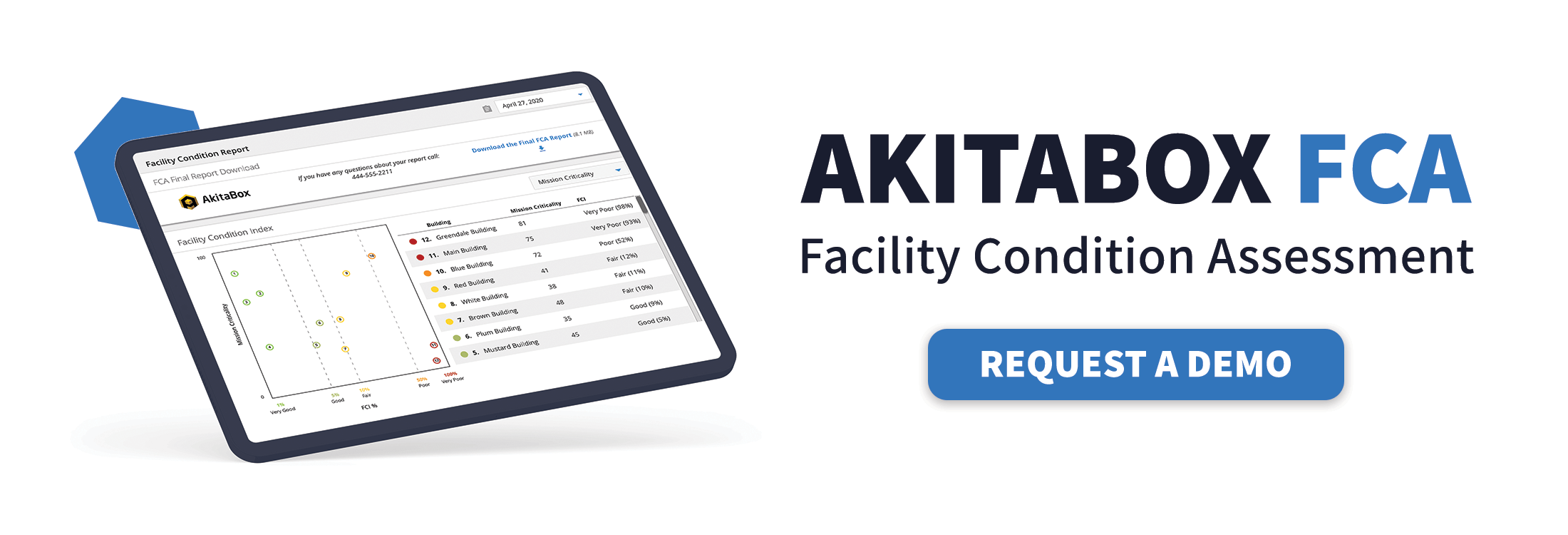Build a Lucrative Facility Assessment Business (While Saving Your Clients Money)
The days of re-doing facility condition assessments (FCAs) from scratch every few years are numbered. The need for always-current facility data – coupled with better technology tools that now make that possible – means “living” FCAs are the future.
A living, or continuous, FCA is one that’s continuously updated with fresh data from the day-to-day activities of managing the facility. And over time, it actually costs your clients less to maintain their FCA instead of re-doing it each time. More on that later.
The idea of maintaining FCA data isn’t new. But the lack of easy-to-use technology tools has made it extremely tough to do so. Now, thanks to new advances in software, that’s changing.
As an AEC firm, this is your time to shine! Building owners and facilities managers want living FCAs – but they don’t know how to get there. If you want to stand out in a sea of competitors, position yourself as the firm that helps bring FCAs to life.
Easier said than done, sure. But it’s absolutely possible.
Casey Morris (National FCA Leader at McKinstry) and Josh Lowe (Chief Solutions Officer and Co-Founder at AkitaBox) revealed how AEC firms can successfully implement living FCAs for their clients in a recent webinar: How to Stand Out from the FCA Competition.
(If you’d rather go straight to the webinar recording and read this article later, just click below. We won’t mind.)
Still with us? Great – let’s do this!
Facilities Managers Want Living FCAs – But They Need Your Help to Do It
The chart below is based on real-life data from Casey’s FCA team over the last decade. Of the 120 FCAs they analyzed, 54 of those clients (45% of the total) had every intention of keeping their FCA alive. They were going to put their FCA results into their own software tool or they planned to continue using the same tool used to conduct their FCA. Either way, they wanted to update the results as changes occurred in their facilities.
When the dust settled after the FCAs were delivered and a year or two had passed, only 19 clients actually developed a work plan to manage that data and truly found a way to keep it alive.

“A lot of owners struggle to start using FCA software and maintain a new FCA data set with their limited resources,” says Casey. “They see the value in maintaining their FCA data. The hard part is changing their workflow, adapting new practices to maintain data, and treating that facility data like they would any other asset that they’ve paid for.”
There’s no one-size-fits-all solution. Every organization has different resources that affect how they’ll be able to maintain their data. Each FCA client needs to build a strategy that will work well for them. It’s a pretty intimidating challenge for facilities managers to tackle – so many of them simply don’t.
This is where having an AEC firm to partner with can make all the difference. Instead of seeing your client once every 5 years for a traditional FCA, you can help them make that initial transition to a living FCA – and provide ongoing consulting support to help them maintain it.
You become so much more than an FCA provider at that point. You’re an essential component of their data management strategy and planning cycle.
So just how can an AEC firm move a facility from a recurring FCA to a continuous FCA? Casey and Josh have some tips and tools to help you get started.
Steal This Sample Workflow for Maintaining FCAs
Keeping an FCA up-to-date really comes down to workflow. These three steps can boost your chances of successfully putting one into practice.
Step 1: Develop a workflow that’s going to work within your client’s organization. Use Casey’s sample workflow below as a starting point. Share the workflow with your client. Work with them to refine it and customize it, deciding which pieces work and which don’t.
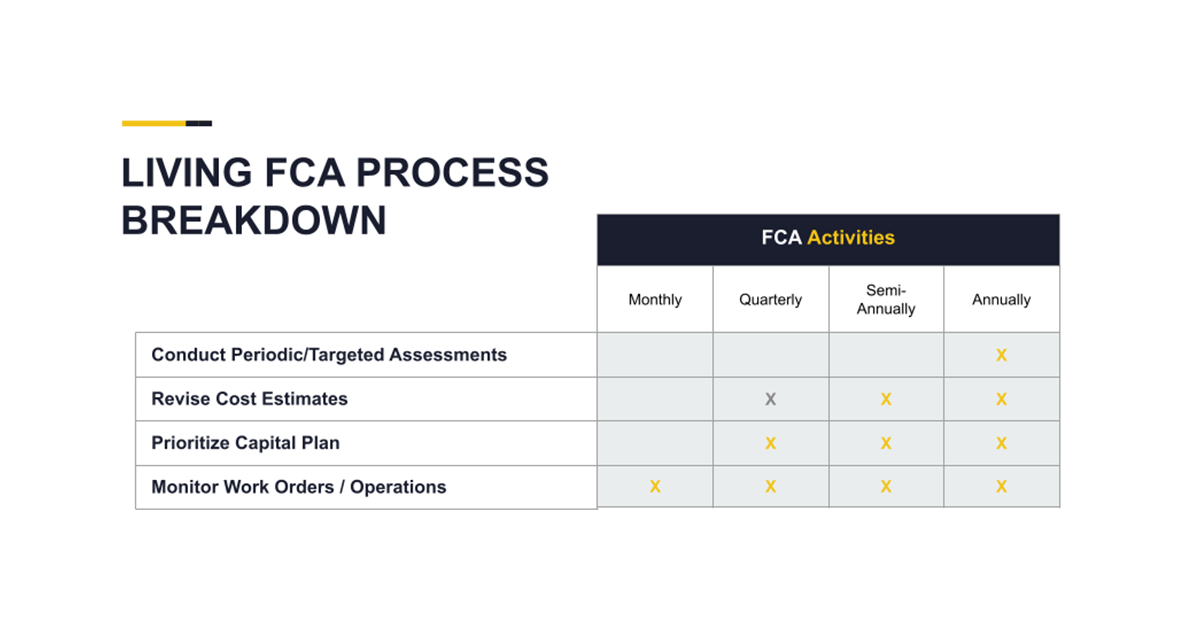
Step 2: Get buy-in from everyone who’ll be impacted by that workflow. You want maintenance, operations, finance, all the way up to the C-suite on board with the workflow. A continuous FCA involves getting different data silos within the organization talking to each other. So everyone living in those silos needs to be willing to work together.
Step 3: Commit to it. Says Casey: “I’ve had clients hire a guy to manage their FCA data and they thought it was going to be the best solution ever. This one guy was going to solely focus on that. I call back three months later and he’s got other jobs now, to the point he’s doing something else completely within the organization.” It’s tempting to go back to doing things the way they’ve always been done. Change is hard. But don’t let the workflow fall apart. Stick to it.
Connect FCA Data with Facilities Management Data
If work order data doesn’t feed into FCA data (and vice versa), it’s practically impossible to maintain an FCA. You won’t know where a facility’s condition stands on any given day.
FCAs already feed into capital planning, budgeting, and other high-level decision making. That’s wonderful. But they’re not connected to work orders and every day operations data – and they need to be.
“We need to create that connected universe, where FCAs are supporting higher-level decisions as well as informing and maintaining your work plan,” says Josh. “For example: The FCA consultant looking at a pump may think it looks brand new, but he doesn’t know that the in-house tech had to rebalance it 10 times last year. Maybe there’s an issue with the pump and you’re spending more money every year than the pump is worth. If your FCA data and your work order data is connected, you’d see that right away. That type of stuff is valuable to know. “
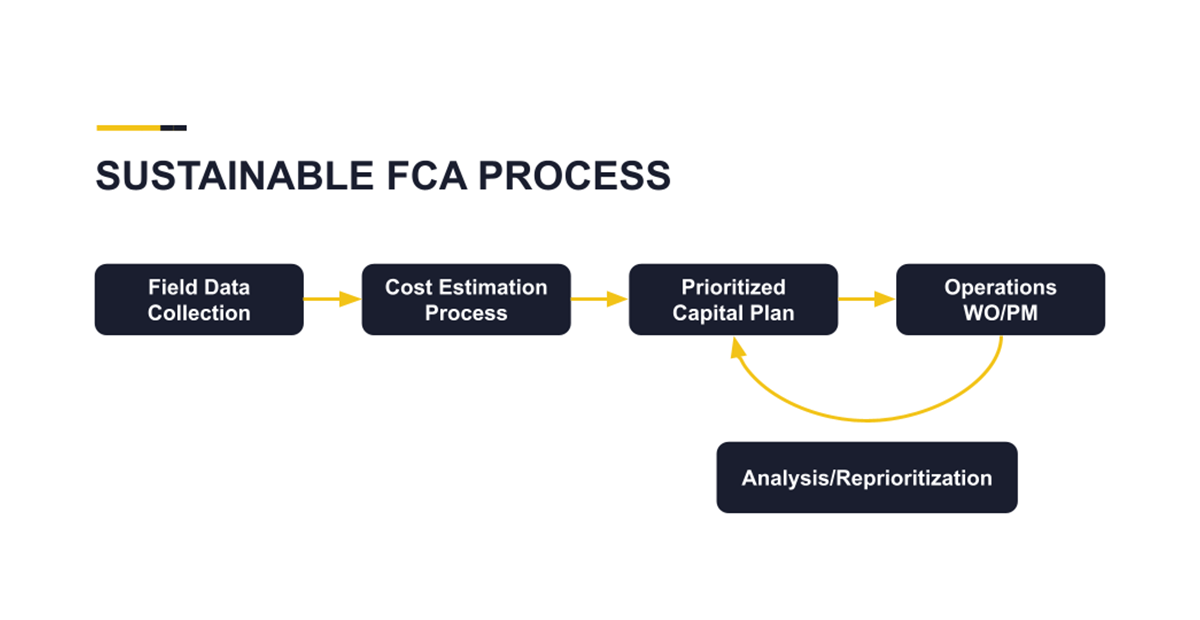
“FCAs need to live on the operations side just as much as they do the budget side,” Casey adds. “That’s the simplest way to frame what we’re talking about.”
Connected data that’s maintained over time also becomes more valuable to you and your client. Take this scenario. You’re a large owner of multiple facilities in Florida, which happens to have a lot of salt water. Your assets might not make it as long as industry averages. Well, the longer you maintain and track your own data, the more valuable that data will become. It’ll tell you that a particular asset doesn’t actually last 15 years like the industry average says. It’s only 8 years at your facility thanks to all the salt water. So you, as the owner, need to start planning replacements for eight years because none of your assets have ever lasted longer.
Connecting and maintaining your own data gives you even more accurate, customized life cycle data and cost estimates – because they’re based on historical data from the actual facility vs. general industry averages.
Use the Right Technology for the Job
Not just any tool will do. If you want to break the cycle of recurring FCAs, you need to collect the data in a sustainable way using a technology that makes it easy to go back and audit it.
If the tool isn’t user-friendly, the folks with boots on the ground aren’t going to like it and won’t use it. If that happens, you quickly start to lose valuable day-to-day data and get forced back into cyclical FCAs.
Making sure the data is collected in a system designed to make data maintenance easy is key.
“Technology changes the game here. You want to use technology with a good user interface (UI) that’ll enable you and your client to do all the things you want with the data,” says Josh.
Once again, your AEC firm to the rescue. When building owners come to you requesting a living FCA, they’ll need your guidance on what technology options there are for maintaining and connecting their data.
A facilities management system like AkitaBox is one to consider. Why? You can conduct the FCA and your client can manage all the facility’s day-to-day operations in one streamlined, integrated platform.
Another reason? A super easy UI. Imagine collecting data on a map and linking it to QR codes on each of the assets. When you stand in front of an asset, you just scan the QR code or click on a map of the floor plan and know that you’re updating the right piece of data. If someone questions you on a data point, you can click on the asset in the software and show them where it is: the mechanical room it’s in, photos of the unit itself, and the complete maintenance record of that unit.
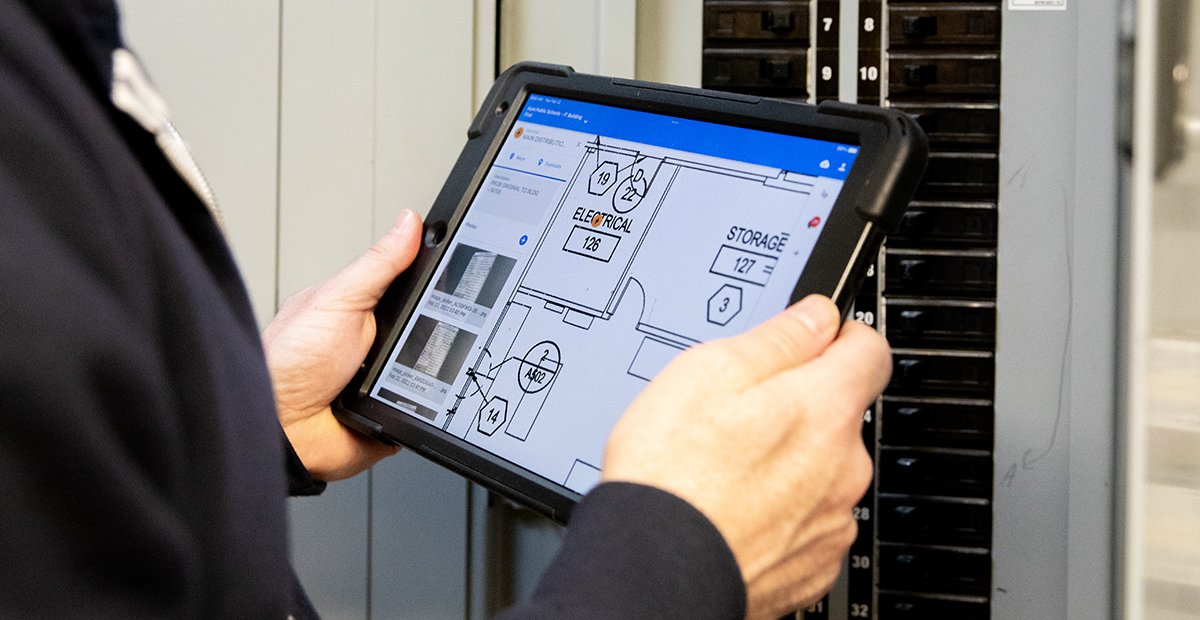
How Living FCAs Save Your Clients Money
FCA data that’s continuously updated has advantages for both your firm and your clients. One of the biggest advantages? It saves your clients money. And we’ve got some real-world numbers to help you prove it to them.
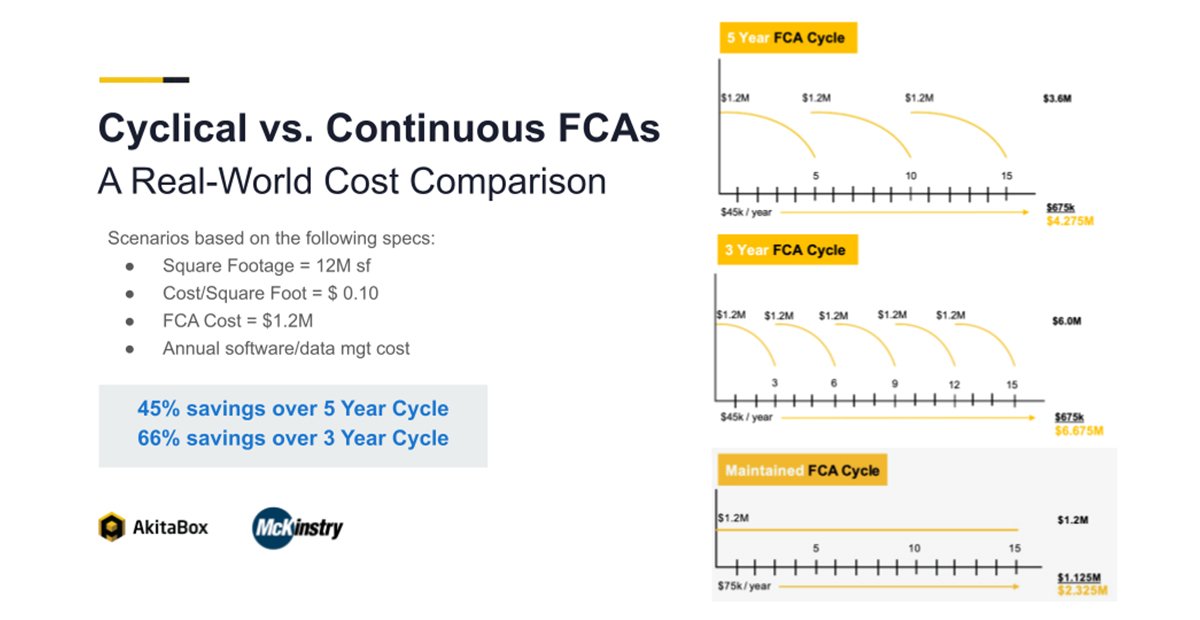
Casey created this illustration based on real costs from a former client. Over 15 years, this client would spend more than a million dollars for every FCA on their 12 million square feet. Every five years, they’d start over with a new FCA – spending another million dollars each time (as you can see in the top chart).
They were stuck in a cycle they couldn’t escape. Over 15 years, they spent more than $4 million total to do recurring FCAs. The real kicker? That total cost included $45,000/year for the FCA software license they used. They were paying for it, but doing nothing with it.
Doing an FCA more often (say, every three years – like in the middle chart) isn’t the answer. In fact, it’s even more expensive than the 5-year FCA cycle.
The bottom chart is what Casey pitched to the client as a way to break the cycle of recurring FCAs. At the start, they’d invest $1.2 million to get the initial FCA done. They’d also spend some money for a software license so they’d have a tool to manage the data.
“Then there’s another $30,000 included for consulting assistance,” says Casey. “I think one thing that those of us in specialty firms and AEC firms can do for our clients is start to commit ourselves (and get the owner to commit to paying us to keep us around) as experts to maintain that data.”
Add it all up – living FCAs are a win for you and a win for your clients.
“It’s a more prudent use of funding to take the continuous FCA approach,” Casey adds. “Your client is able to keep that initial investment alive.”
Before You Go …
If you’re interested in building your FCA business, becoming more competitive, and delivering long-term value to your clients, we’re here to help. AkitaBox FCA software makes collecting, organizing, reporting – and maintaining – FCA data incredibly simple.
Don’t forget to check out the full webinar: How to Stand Out from the FCA Competition
And if you’d like a closer look at our location-based data collection software, we’d love to show you!



